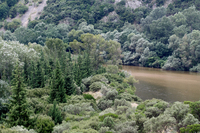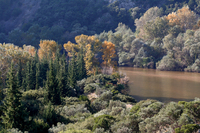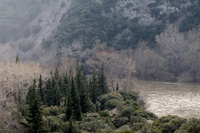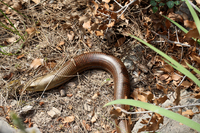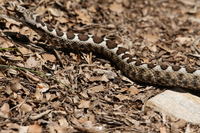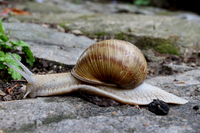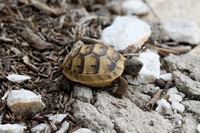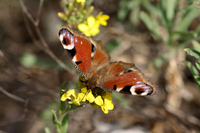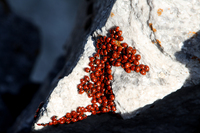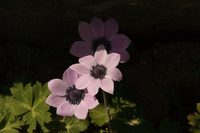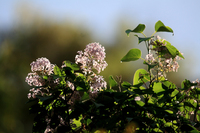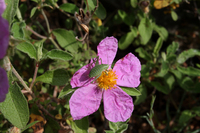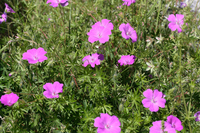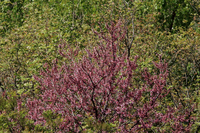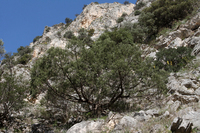Kiosk
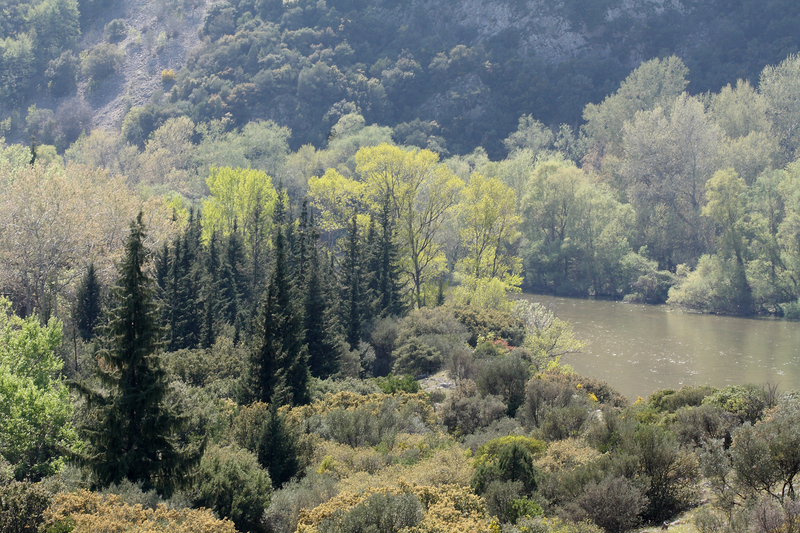

Reaching the end of a long turn of the path and on a great spot for panoramic view, after walking for about 20 minutes, we are given the chance to examine the area from north to south and observe the great variety of the landscape and especially the variety in vegetation. In spring the bright and tender leaves on the trees and bushes, along with the wild flowers which have a wide colouration range, mark the beginning of a new and promising season for all the plants and animals of the area. From the shores of the river all the way up to the sheer cliffs, various plant and animal species coexist or try to overcome each other. The path continues from this point and towards north up to the centre of the Straits of Nestos, where there is the abandoned railway station of Livera. There are also some really well shaped stone paths, for those who would like to follow them, and they lead lower down to the river at the dense riparian vegetation where someone comes close to the river and its flow. Kiosk
Reaching the end of a long turn and from a great spot for panoramic view, after walking for about 20 minutes, we are given the chance to examine the area from north to south and observe the great variety of the landscape and especially the variety in vegetation.
In summer and during the warm hours of the day, the breeze coming from the slopes and as it travels through the straits of Nestos, it refreshes the visitors and motivates them to come down to the river banks in order to freshen up and enjoy the perpetual motion of the river’s waters.
Kiosk
Reaching the end of a long turn and from a great spot for panoramic view, after walking for about 20 minutes, we are given the chance to examine the area from north to south and observe the great variety of the landscape and especially the variety in vegetation.
Winter brings out the peace and the tranquillity of the place. Nature rests from the deciduous, fruiting and production rates of the previous seasons. Rain and snow are welcomed at a place which absolutely needs them. legless lizard
Often our route on the path is disturbed by a fast and noisy crawl between the rocks and the bushes. The presence of a reptile known as legless lizard (Pseodopus, ή Ophisaurus apodus) is very common and means no harm at all for the people walking the path. The legless lizard is a lizard often longer than one meter, which during its evolution lost its limbs, resulting to its today appearance to be more of a snake than a lizard. The legless lizard prefers to stay in cool places and it mainly feeds on other invertebrates. Viper
Rarely found in the area, however dangerous, is the viper (Vipera ammodytes). It could be found mainly on sunny, dry and rocky areas with sparse vegetation, however the snake’s instant reaction is to rush into a hide when it feels the human presence close by. The viper does not exceed the length of one meter and its colour varies from different shades of beige – brown with a characteristic intense pattern present always on the snake’s back. The viper feeds on small rodents, birds and other reptiles. When the snake feels in danger, it coils and starts hissing in order to warn its possible threat. The Greek tortoise
The Greek tortoise or Testudo Graeca as is its scientific name, is a protected species by the Greek and the European legislation. The tortoise has a constant appearance in the region from spring up to the autumn’s months. The tortoise feeds on a variety of plants as well as on some invertebrate species. The photograph shoes a juvenile male turtle. Invertebrates
In the region there are many animal societies of invertebrates. Therefore, there are several species of land snails such as the edible Helix pomatia & aspersa.
In the region of the Straits of Nestos, the plethora of insects is impressive. The presence of insects is supported from the great variety of different plants. Among these several species of insects are the butterflies. A very characteristic butterfly species which belongs to the family of Nymphalidae, is the species Inachis io, which is also known as the Peacock Butterfly.
Very often during the winter months, Ladybirds (Coccinellinae) gather in dense groups and large numbers in order to go through the winter in sheltered and sunny places, up to the point they will become active again when the spring will come. Wild flowers
Depending on the season, several wild flowers, like crocuses but also aromatic herbs such as mint and thyme, fill the space with colours and nice smells. Early in spring Anemones (Anemone pavonina var. Purpureoviolacea) stand out in sunny and dry rocks.
In late spring, lilacs, (Syringa vulgaris), which grow in more humid places with more dense vegetation, are impressive with their rich flowering.
During the summer months, in the same places, the Cistus (Cistus incanus), with its pink flowers and leathery leaves, succeeds the equivalent spring vegetation. But there is a great variety of geraniums (Geranium), which grow and thrive at locations more humid and shaded. During the whole year, the bushes and the evergreen trees such as wild olive trees and cedars prevail. While in more humid places lower towards the river, but also through the ravines thrive the redbuds (Cercis siliquastrum). Common however rarely found in Greece is the wild juniper (Juniperus excels). This precious tree grows and thrives mainly in remote and difficult to access slopes. Usually in the region, we find the wild juniper exposed to bright light exploiting even the minimal moisture, which is trapped in limestone rocks of the area.


